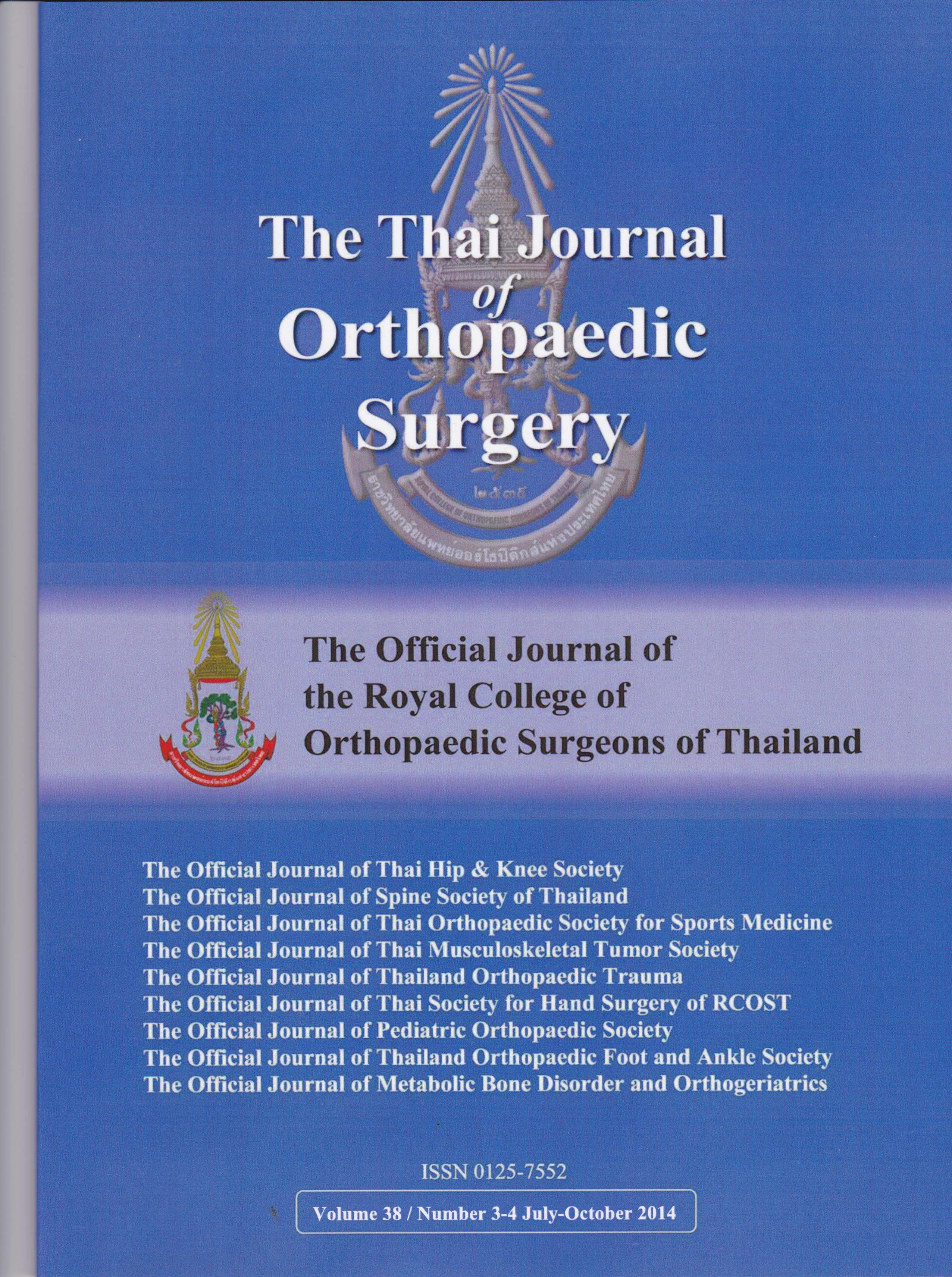Geriatric Hip Fracture Pathway in Private Hospital: Early results
Main Article Content
Abstract
Purpose: A prospective study was performed according to the Geriatric Hip Fracture Pathway in patients who sustained a hip fracture and were admitted to Bangkok Hospital.
Methods: Eligibility criteria were defined as aged over 60 and a hip fracture caused by simple fall. From July 1st, 2013 to July 31st, 2014, the number of patients with hip fractures aged over 60 years was 57.
Results: The average age was 77 years, with 13 males (23%) and 44 females (77%). There were 27 cases of femoral neck fractures (47.5%), 27 cases of intertrochanteric fractures (47.5%), and 3 cases of subtrochanteric fractures (5%). The operations performed were 2 total hip arthroplasties, 23 bipolar hip hemiarthroplasties, and 32 internal fixations.The performance indicators according to the 2013 annual report of the Nation Hip Fracture Data of the United Kingdom (NHFD) were recorded and evaluated. The timing of operation within 36 hours could achieve 82% with 100% of complete geriatric pre-operative assessment and no infection at the surgical site. All patients had deep vein thrombosis prophylaxis, no development of bed sores, no mortality, no reoperation within 28 days, no readmission within 28 days, and no secondary hip fractures. The average length of stay was 15 days with the median at 10.5 days and 74% of osteoporosis assessment with proper treatment.
Conclusion: Most of the actual performances could hit the target in comparison with the NHFD. However, the patients might be followed up for a longer period to evaluate the balancing score and the prevention of second hip fractures. Although this pathway has only been in place for one year, we may conclude that the overall results are satisfactory and the geriatric hip fracture pathway should be continued with some modifications for a better result in our hospital.
Article Details
References
2. The care of patients with fragility fracture. London: British Orthopaedic Association 2007: 4-7.
3. Friedman SM, Mendelson DA, Kates SL, McCann RM. Geriatric co-management of proximal femur fractures: total quality management and protocol-driven care result in better outcomes for a frail patient population. J Am Geriatr Soc 2008; 56: 1349-56.
4. Barrett L, Jaglal S. Inpatient rehabilitation to help manage osteoporosis and reduce further risk: an Ontario best practice model. Osteoporosis update 2007: 4-5.
5. Management of hip fracture in older people. Edinburgh, Scotland: Scottish Intercollegiate Guidelines Network (SIGN) 2009: 4.
6. Wongtriratanachai P, Luevitoonvechkij S, Songpatanasilp T, Sribunditkul S, Leerapun T, Phadungkiat S, et al. Increasing incidence of hip fracture in Chiang Mai, Thailand. J Clin Densitom 2013; 16: 347-52.
7. Roche JJ, Wenn RT, Sahota O, Moran CG. Effect of comorbidities and postoperative complications on mortality after hip fracture in elderly people: prospective observational cohort study. BMJ 2005; 331: 1374.
8. Bottle A, Aylin P. Mortality associated with delay in operation after hip fracture: observational study. BMJ 2006; 332: 947-51.
9. Mitani S, Shimizu M, Abo M, Hagino H, Kurozawa Y. Risk factors for second hip fractures among elderly patients. J Orthop Sci 2010; 15: 192-7.
10. Angthong C, Suntharapa T, Harnroongroj T. Major risk factors for the second controlateral hip fracture in the elderly. Acta Orthop Traumatol Turc 2009; 43: 193-8.
11. National hip fracture database. British Orthopaedic Association: National report 2013: 5-16.


